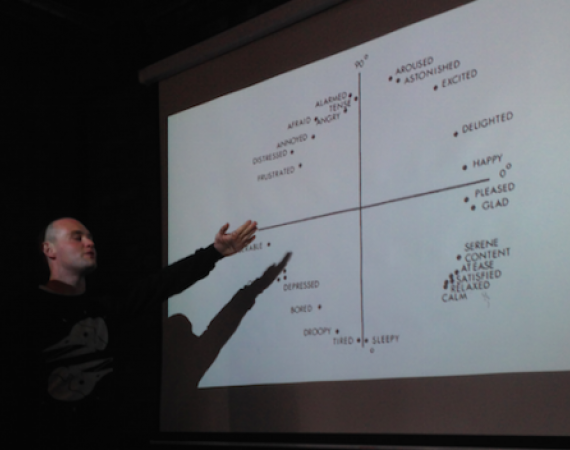Lunchtime talk write-up
Posted on Wed 3 Jun 2015
Designing interactions with tone of voice
On Friday 29 May we welcomed designer Andrew Cook to the Studio to talk about Six Speaking Chairs; his PhD research project completed in collaboration with Graham Pullin.

Andrew Cook
On Friday 29 May we welcomed designer Andrew Cook to the Studio to talk about Six Speaking Chairs; his PhD research project completed in collaboration with Graham Pullin. Using six mis-matched charity shop chairs, Andrew and Graham created six interfaces, each offering a different way to control tone of voice in synthesized speech. Here are five things I learned about six chairs:
- Until recently, people who needed communication aids typically communicated through written text. Now, voice synthesizers are more commonly used, and the overriding intention is for them to produce fluent and human-like voices. There is an aim for neutral intonation, with no undue stress on any words. Typographer and designer Erik Spiekermann argued that a neutral tone of voice does not exist; ‘you cannot not communicate’.
- Andrew and Graham decided to take a sideways look at different design philosophies and research methods to focus on different ways to control tone of voice in a synthesizer. They restricted the range of vocabulary to four words: hello, no, really, and yes. Research indicated that these words could be interpreted in numerous ways dependent on the tone of voice.
- Each chair offered a different design mechanism with which to control the tone of voice parameters. Chair no. 2: the happy/sad chair echoed a wheel of emotions through a circular radio dial with emotions mapped around it. The user tunes the dial to select the appropriate emotion; from anger through to joy; as well as the intensity of the emotion from neutral to fully-blown. Andrew reflected that the analogue radio dial can be seen an emblematic archetype or cultural memory, and the motion of selecting the emotion akin to safe cracking.
- A key concept of verbal communication that is unattainable to people dependent on voice synthesizers is the subconscious utterances and subtle vocal gestures we constantly make in conversational patterns, such as; ‘mmm’ and ‘yeah’. Chair no. 5: the reassuring/undermining chair addressed this absence by designing an interactive interface that could be subtly activated with drumsticks without thought.
- Andrew’s designs were influenced by Zen Buddhist principles and the idea that focusing on the materials you have and the nature around you will allow the barrier to the subconscious to be lifted and ultimately enable you to operate in a more focused way.
I’ll leave you with this question raised from the concept behind Chair no. 6; if you only had access to 17 tones of voice for the rest of your life; inclusive of emotion, voice quality and intent; which would you choose?